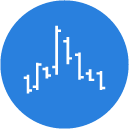 Page top
Page top
 Previous
Previous
 Homepage
Homepage
 Next
Next
Candlestick Chart
Description
As known as a Japanese Candlestick Chart.
This type of chart is used as a trading tool to visualise and analyse the price movements over time for securities, derivatives, currencies, stocks, bonds, commodities, etc. Although the symbols used in Candlestick Charts resemble a Box Plot, they function differently and therefore, are not to be confused with one another.
Candlestick Charts display multiple bits of price information such as the open price, close price, highest price and lowest price through the use of candlestick-like symbols. Each symbol represents the compressed trading activity for a single time period (a minute, hour, day, month, etc). Each Candlestick symbol is plotted along a time scale on the x-axis, to show the trading activity over time.
The main rectangle in the symbol is known as the real body, which is used to display the range between the open and close price of that time period. While the lines extending from the bottom and top of the real body is known as the lower and upper shadows (or wick). Each shadow represents the highest or lowest price traded during the time period represented. When the market is Bullish (the closing price is higher than it opened), then the body is coloured typically white or green. But when the market is Bearish (the closing price is lower than it opened), then the body is usually coloured either black or red.
Candlestick Charts are great for detecting and predicting market trends over time and are useful for interpreting the day-to-day sentiment of the market, through each candlestick symbol's colouring and shape. For example, the longer the body is, the more intense the selling or buying pressure is. While, a very short body, would indicate that there is very little price movement in that time period and represents consolidation.
Candlestick Charts help reveal the market psychology (the fear and greed experienced by sellers and buyers) through the various indicators, such as shape and colour, but also by the many identifiable patterns that can be found in Candlestick Charts. In total, there are 42 recognised patterns that are divided into simple and complex patterns. These patterns found in Candlestick Charts are useful for displaying price relationships and can be used for predicting the possible future movement of the market. You can find a list and description of each pattern here.
Please bear in mind, that Candlestick Charts don't express the events taking place between the open and close price - only the relationship between the two prices. So you can't tell how volatile trading was within that single time period.
Functions
Anatomy
Tools to Generate Visualisation
Code-based:
Aaron Beppu’s Block (DS.js)
amCharts (JS)
AnyChart (JS)
CanvasJS (JS)
Google Charts (HTML5)
JSCharting (JS)
plotly (Python)
Vega-Lite
ZingChart (JS)
ZoomCharts (JS)
Webapp:
Google Docs
Infogram
Desktop App:
Microsoft Excel
Tableau



